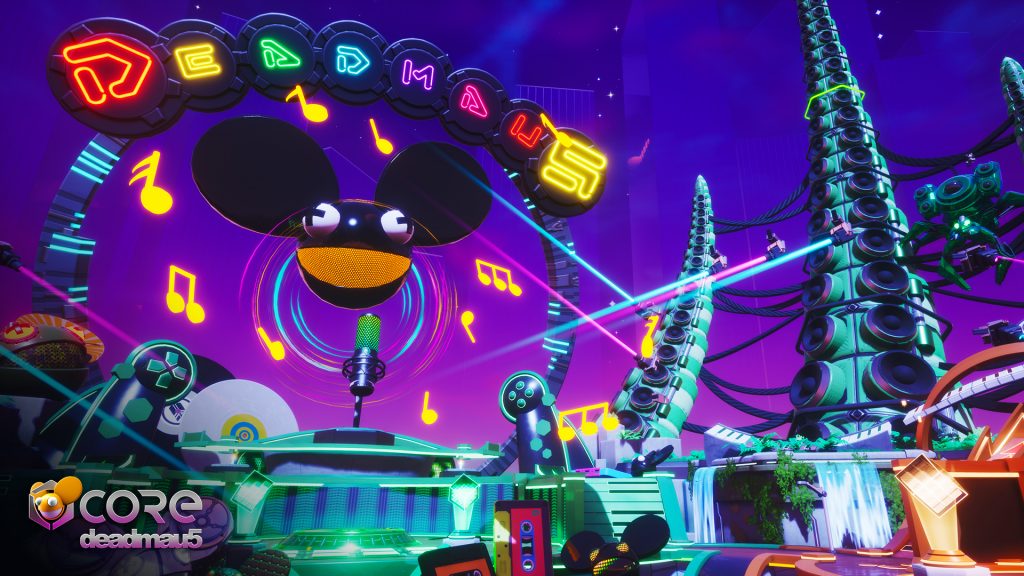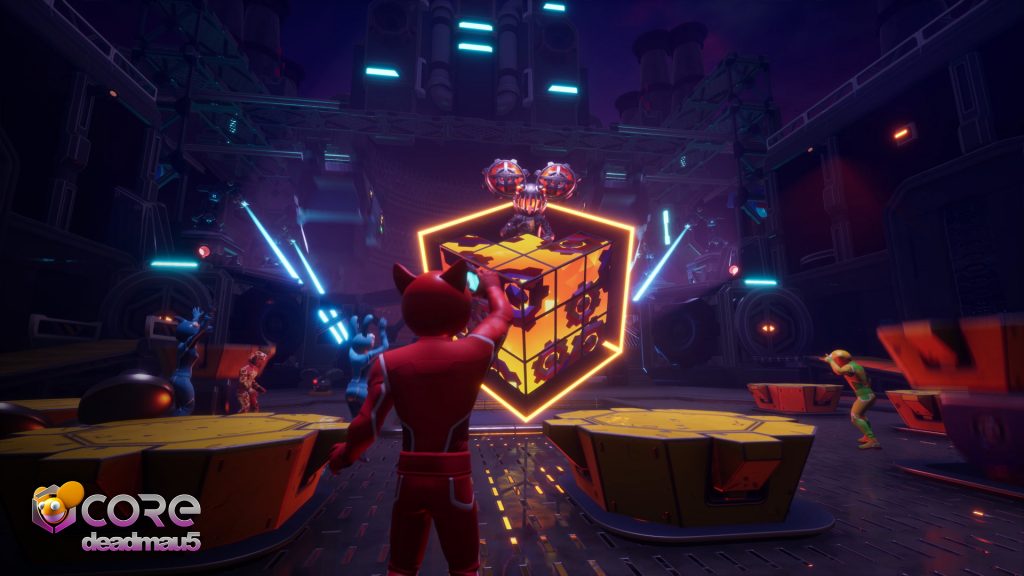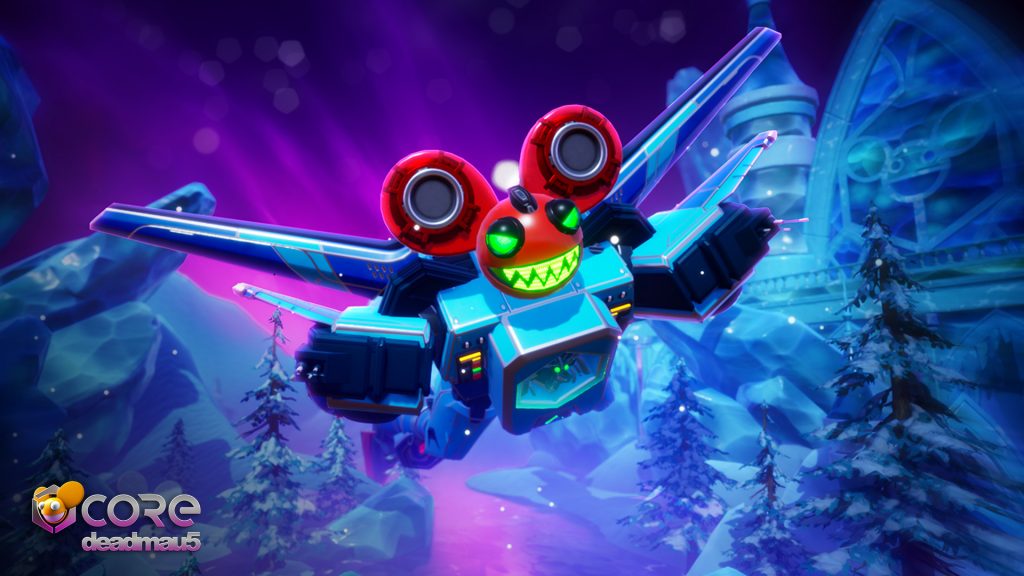There are some amazing platforms emerging in which online games act as universes where shared online experiences can be created and shared. Stalwarts like Roblox have received a lot of press, as have newcomers like Yahaha.
Core, from Manticore, launched into early access less than a year ago and hit the headlines when Oberhasli joined the platform. Oberhasli is the digital world envisioned by top DJ and musician deadmau5. Inside Core, you can jump into Oberhasli to play games inspired by the music of deadmau5, experience exclusive interactive concerts, and hang out with other fans.
We spoke with Dan Fessler, Art Director for Games, about Oberhasli and about working with deadmau5’s metaverse vision. Chatting with BeyondGames.biz this month, he also spoke about user-generated content, the future of the Core platform and the opportunities ahead.
“Our technology-influenced approach to art would play a huge role in how we built Core”
Dan Fessler
BeyondGames.biz: Give us a quick insight into your background. How did you come to be the art director for games at Core?
Dan Fessler: I’ve been working with the founders of Manticore, Jordan Maynard and Frederic Descamps, for over 10 years on many different projects across three different companies, so much of my career growth has largely been tied at the hip with the same group of people. We’ve built a lot of trust and we intimately understand each other’s strengths and weaknesses, which helps us execute extremely fast.
My background is actually as a pixel artist in mobile gaming. This was in the pre-iPhone era of mobile gaming, and after all consoles had moved on to real-time 3D. Phones were the last platform that actually required professional pixel artists. It was a dying medium, and it wasn’t nearly as in vogue as it is today with the rise of indie games, but luckily that landed me my first industry jobs at Gameloft and, shortly after, Glu Mobile.
It was because of my background in pixel art that I initially met Jordan and Frederic. They had just founded a startup called A Bit Lucky, and were making a game called Lucky Train; a sort of city builder revolving around rail transportation. They were big fans of the style and were looking for someone to help create their pixel isometric worlds and trains. They had given me an art test to create an isometric train rotated in eight directions. I’m always looking for ways to leverage tools to maximize efficiency, and hand-drawing exact rotations of isometric objects is extremely tedious. So what I turned in was a pipeline for creating the trains in 3D first, then using that as a base to clean up and pixel on top of. The result was double the directions in about half the time. It was that tech-oriented approach to art that solidified our relationship moving forward.
Since then I’ve always used whatever project we’ve worked on as an excuse to learn new skills and level up. After Lucky Train, we made another city-builder called Lucky Space which was entirely pre-rendered 3D graphics which got me more familiar with 3D pipelines. After that, we were acquired by Zynga and released Solstice Arena, a real-time 3D MOBA game for iPad. It was then that I started leaning more towards art direction. I directed art on Solstice Arena, Empires & Allies, and Mountain Goat Mountain.
After about four years at Zynga working on various projects including in the R&D/VR division, Jordan and Frederic approached me again to join their new startup, Manticore Games, and I was the first to say yes. So I’ve been with this company from essentially the very beginning. That existing history of working together, and our technology-influenced approach to art would play a huge role in how we built Core – particularly in how we build tools to empower a new generation of 3D artists.
What makes the Oberhasli vision unique? What makes the relationship between Core’s gaming platform and deadmau5’s music so strong?
Deadmau5 and his fans have always been very technology-forward, so in that sense, it was a perfect match for us. Joel (deadmau5) is quite the technical artist himself and integrates new technologies into his shows whenever he can. One of the projects he’s been talking about behind the scenes for a while now was Oberhasli. To him, Oberhasli wasn’t to be just another virtual concert like we’ve seen done before, but rather a new way to continually interact with his fans in a more personal and direct way. One that’s not constrained by the realities of music distribution today.
What he was describing was essentially his slice of the metaverse, and he saw that, after experimenting with Core on his own, the platform could empower him to achieve it. Core does a lot of the heavy lifting that otherwise would be too prohibitive for anyone without many millions to spend – multiplayer infrastructure, server hosting, tooling, and so on.

Core and Oberhasli are not like traditional games. How would you describe it to a newcomer?
Core was born as a user-generated content (UGC) gaming platform to make game creation more accessible to everyone, regardless of their experience in game design. The goal was to provide a one-stop shop for creators to make, publish, and monetize experiences and, for players, to find an endless arcade of games and interactive experiences to enjoy, share and discover.
Recently, however, we’ve been exploring interactive experiences that aren’t necessarily games at all, nor focus on gamers as a target audience. Not every virtual immersive experience has to be a “game” in the traditional sense, but can be something that anyone from a wide range of backgrounds and interests can find value in.
Oberhasli represents our first big push in this direction. Oberhasli includes worlds to explore inspired by deadmau5’s music created by his own fans, mini-games to participate in, and spaces for fans to socialize and perhaps even interact directly with Joel himself. It also included a live concert which he plans to continually update. It was an experience crafted for deadmau5 fans first and foremost.
What do you see as the core (pardon the pun) design principles of Oberhasli? And how much of that is from you, and how much directly from deadmau5?
We wanted Oberhasli to be a meaningful space to spend time in. Involving deadmau5’s fans was a key part of that. Having them build parts of Oberhasli speaks to how this world is really as much theirs as it is his. For style, it’s a mix of our own “Core” aesthetic and tons of elements from Joel and the deadmau5 brand. Sasha Baryshnikova, our environment art director, scoured reference material from his shows, streams, or anything she could find to help inform elements of the world.
Joel was an amazing collaborator. On top of being a big fan of Core, he’s extremely technical and very knowledgeable about Unreal (the same engine Core is built on top of). I was surprised to learn that he comes from a 3D graphics background and stays on top of new technologies. Every time we met up to go over the progress, it was just a bunch of “Hell yeah! And let’s add this too!” He even gave us models for characters from his Pomegranate music video which we ended up releasing as player cosmetics during the event.
Since Core is heavily based around the concept of kitbashing, most of the parts used to create Oberhasli were actually already in Core. We created the world in the same way our creators would have, only adding a couple of custom parts or features that was absolutely necessary. You can read more about our kitbash approach to art here on our site.
For the concert itself, we knew it needed to be something that you couldn’t experience in any other medium. It couldn’t be just an analogue to a real-world concert with added friction. We wanted it to be interactive, but not too interactive as to be distracting from the main feature: the music. It’s a slippery slope to adding game mechanics and suddenly it’s not an amazing concert experience with interactive elements, but rather shallow mini-games with an over-the-top soundtrack. We’ve seen other virtual concerts fall into both of these traps.
Perhaps the hardest challenge was simply syncing everything to the beat in a multiplayer setting. Syncing events to audio is a challenge itself, one that we needed to build custom tech for, but doing that over the network with 32 players is a dark art. Untold amounts of iteration and trickery went into making that possible.
In the end, I think it all paid off. The reception we got from his fans was phenomenal, and honestly the highlight of my career to date.

What is your understanding of what “the metaverse” is and why is everybody talking about it right now?
That’s a great question, and it’s a hard one to answer because it’s not really just one thing, but rather a collection of concepts that interplay together. Depending on who you ask, people will tend to focus more on one aspect or another.
But I mostly see two main conversations happening on the topic. You’ve got the web3 crowd, who rally behind interoperability and ownership being the main tentpole of the metaverse. And you’ve got the more centralized organizations like Meta, Epic or Microsoft who primarily rally behind virtual immersion as being the primary tentpole. I think both are valid, and Core already has a huge head start in both of these directions.
People are realizing that virtual social experiences, virtual ownership, and virtual creation are much bigger than just games, as it has been relegated to in the past. It’s kicking off a new gold rush to discover and develop valuable experiences for everyone. For us, Oberhasli validated this thesis and we plan to continue to focus on broader experiences outside of hardcore games for hardcore gamers.
We are building a UGC metaverse that is empowering a large wave of creativity with a new generation of creators now enabled to make games and experiences. Before that, creating games was reserved for professionals. Now, with platforms like Core, everybody can create their own games and experiences. We are seeing a democratization of creativity like never before.
Does our understanding of what a “game” is need to change in future? Not just for Core, but generally?
I don’t think we need to change our understanding of what a game is, but rather the opposite; broadening our understanding of game-like virtual experiences to include things that are decidedly not games. Just because you are socializing with a 3D avatar, does that make it a game? Even the term “player” is loaded. We are deeply rooted in the idea that these virtual experiences are play-things for gamers and not to be taken seriously by the general public or to be valued as intrinsic parts of modern-day culture, and that’s what’s holding us back.
I think gamers already understand this, but getting everyone else on board is still a challenge. It will happen with time as we continue to find valuable experiences that speak directly to them. It’s still very early and I don’t think a compelling case has been made to the general public yet, but It will come in time. Work meetings or social hangouts with 3D avatars simply isn’t enough.
How are things changing for music creators? How much will metaverse experiences change the traditional structure of the music business?
In my opinion, things will change as much as the music creators want to explore. We’ve seen great initiatives so far that combine both the games and the music industry. Working with Joel [deadmau5] has been a huge pleasure for so many reasons, but one that stands over the rest is how techno-progressive he is. His pitch to us on Oberhasli was exactly that – to fundamentally change the music business and distribution model to one that is more artist-owned, and with a tighter connection to the fanbase. I’m excited to see how it develops and privileged that Core gets to play a part.
How the business will evolve is a discussion that depends on so many players (musicians, labels, streaming companies) that it’s difficult to make a solid statement, but I’m sure that recent initiatives have proven that there are potential ways to collaborate and build a new way to experience music.
How much of Core’s success, and the growth of the metaverse, was hastened by the pandemic? Will things change when real-world venues open up for gigs again?
It’s true that the global pandemic has changed a bit the way we all hang out together on a daily basis, and this has impacted how the metaverse is evolving for sure.
Having lockdown situations in so many countries has unlocked new opportunities to communicate with friends, family and even strangers that can become friends later, in the same way that online gaming did in the past. We’re just scratching the surface about how to use the metaverse to offer ways to interact with other people online.
While the pandemic may have encouraged the adoption of new social platforms and media, the value people get from them will continue to be valuable far into the future.

What advice do you have for other creators looking to participate in the Core metaverse?
Just dive in! Our platform is completely free to use and you can get building right away. There are plenty of example projects and online resources to help get you started and familiar with the platform. We’ve gone to great lengths to make it the easiest way to make online games and experiences.
Start small, and work towards bigger and bigger projects. Dissect how other people have made things from our community content. Get involved with our great Discord community, who continually lift each other up. I think you’ll be surprised what you could achieve.
Where is Core going in 2022? What big things are on the horizon for you?
That’s a great question, and an intriguing one as well. We’re checking what our next steps are at the moment, and don’t want to spoil any surprises, but you can look forward to seeing more social experiences within Core.
With Oberhasli and the Axial Tilt initiative that allowed us to stream The Game Awards within Core creating a metaverse around the show, we’re open to exploring more social experiences in the coming months. We have some ideas in the carts at the moment, but if any brand or developer wants to reach out to us with any idea or inquiry, we are more than happy to discuss opportunities!
“Working with Deadmau5 has been a pleasure for many reasons, but one that stands out is how techno-progressive he is”
Dan Fessler
Discover more ways in which games meet music in our exploratory feature. Dan Fessler’s colleague at Manticore, Frederic Descamps, delivered an inspirational video talk here which you can watch today.
Professional geek Dave is COO of Steel Media, the company behind Beyond Games. He oversees various events, marketing and editorial teams. Dave started his career writing game reviews in the 1990s and he’s since served as editor-in-chief of publications such as the official Microsoft magazine and entertainment mag SFX.



































